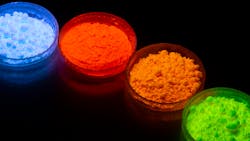Barry on Batteries: Advancing Battery Materials with Blending and Recovery Innovations
As demand for electric vehicles (EV) grows, chemical companies are stepping up to supply battery materials, both powders and liquids. Each presents unique challenges that battery-material manufacturers must consider as they reach the blending and recovery stages.
For liquids, including sulfates, hydroxides and carbonates, high purity and high product effectiveness are the goal. Depending upon the flow rates and the specific process conditions (such as percent solids or fines), processors will need to install bag and cartridge filtration between 0.45-micron and 1-micron units. For more automated systems, battery-material processors should use enclosed filter presses, candle filters and pressure plate filters.
Solids Blending Considerations
The characteristics of dry solids, such as particle size, free-flowing versus sticky solids and dusting, call for rigorous testing and data collection to determine the most appropriate blending technology.
Typically, pugmill and pin blenders are optimal for homogeneous mixing. A pugmill unit allows for gentle blending using dual or single shafts fitted with paddles that move the product forward and partially in reverse. This slow-speed, high-torque approach increases the residence time, which means the pugmill handles sticky powders well. A pin blender is a single shaft fitted with rods or pins. The centrifugal rotation blends the products, which makes this particular design advantageous for working with free-flowing, non-abrasive powders.
Other interesting options include tumble or cone blenders. These units, similar to the pin and pugmill mixers, come with vertical shafts and blades. This technology provides both high- and low-speed shear blending. The low speed works for handling sticky products and reducing the chance of particle-size reduction when crystal breaking is a risk.
Understanding Extrusion
Another option to consider in battery-material blending and recovery is extrusion. Common extrusion applications include graphite production (granulation), separator sheets and polymer-gel electrolytes, anode and cathode material compounding and solid-state electrolytes.
Extrusion technology refers to the processing of solids in a long barrel with the design of the screw determining the relevant unit operations. A single, twin or multi-design screw can shear, melt, disperse, compress and granulate and compound the solids, depending on the product being produced. Zone pressure and temperature are controlled and measured during the flow to suit different applications.
Take a Holistic Approach
The above technologies range from lab-scale and research capacities (kilograms/hour) to full-scale production (tons/hour). They can be inerted for safe testing and operation and designed with different types of metallurgy and seals/gaskets depending upon the nature of the products being manufactured.
Battery-material manufacturers should take a holistic approach to downstream technology decisions to develop an optimum design. This involves solving questions by looking at blending and recovery as a single, integrated process rather than individual steps.
About the Author
Barry Perlmutter
President of Perlmutter & Idea Development (P&ID) LLC
Barry Perlmutter is president of Perlmutter & Idea Development (P&ID) LLC. He has over 40 years of science, engineering and business marketing experience in the field of solid-liquid separation including filtration, centrifugation, process drying, mixing and recycling. His strong professional skills focus on process and project solutions, innovation strategies and execution, market expansion and business development. Barry has published and presented worldwide on applications in the chemical, pharmaceutical, and energy/environmental industries and has been responsible for introducing many European technologies into the Americas marketplace. His two books, published by Elsevier, Amsterdam, "Handbook of Solid-Liquid Filtration" and "Integration & Optimization of Unit Operations" are used worldwide for process guidance.

